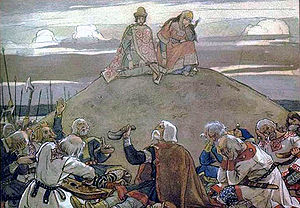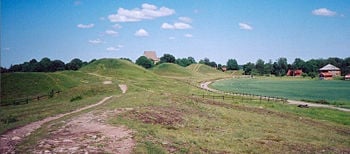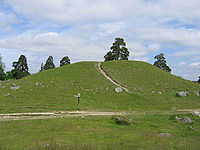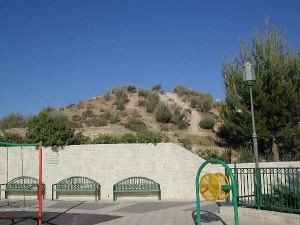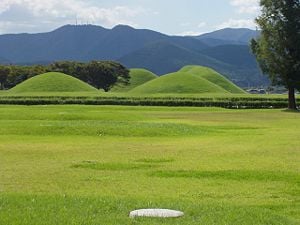Difference between revisions of "Tumulus" - New World Encyclopedia
| Line 31: | Line 31: | ||
====Bin Tepeler and other Lydian Tumulus Sites==== | ====Bin Tepeler and other Lydian Tumulus Sites==== | ||
| − | |||
This is the most important of the enumerated sites with the number of specimens it has and with the dimensions of certain among them. It is in the [[Aegean Sea|Aegean]] inland of Turkey. The site is called "Bin Tepeler" (a thousand mounds in Turkish) and it is in the northwest of [[Salihli]] district of [[Manisa Province|Manisa]] province. The site is very close to the southern shoreline of [[Lake Marmara]] (Lake Gyges or Gygaea). Bin Tepeler is a [[Lydian]] [[necropolis]] which dates back to 7th and 6th centuries B.C.E. These mounds are called "the pyramids of Anatolia" as there is even a giant specimen among them which attains 355 meters in diameter, 1115 meters in perimeter and 69 meters of height. According to the accounts drawn up by [[Herodotus]], this giant tumulus belongs to the famous Lydian King [[Alyattes II]] who ruled between 619-560 B.C.E. There is also another mound belonging to King [[Gyges of Lydia|Gyges]]. The Gyges mound was excavated but the burial chamber hasn't been found yet. In this site, there are 75 tumuli dating back to Lydian period which belong to the nobility. A large number of smaller artificial mounds can also be observed in the site. There are other Lydian tumuli sites around [[Eşme]] district of [[Uşak Province|Uşak]] province. Certain mounds in these sites had been plundered by raiders in the late 1960s and the Lydian treasures found in their burial chambers had been smuggled to United States which later had to cede them to Turkish authorities after a series of negotiations. These artifacts are now exhibited in the Archaeological Museum of Uşak. | This is the most important of the enumerated sites with the number of specimens it has and with the dimensions of certain among them. It is in the [[Aegean Sea|Aegean]] inland of Turkey. The site is called "Bin Tepeler" (a thousand mounds in Turkish) and it is in the northwest of [[Salihli]] district of [[Manisa Province|Manisa]] province. The site is very close to the southern shoreline of [[Lake Marmara]] (Lake Gyges or Gygaea). Bin Tepeler is a [[Lydian]] [[necropolis]] which dates back to 7th and 6th centuries B.C.E. These mounds are called "the pyramids of Anatolia" as there is even a giant specimen among them which attains 355 meters in diameter, 1115 meters in perimeter and 69 meters of height. According to the accounts drawn up by [[Herodotus]], this giant tumulus belongs to the famous Lydian King [[Alyattes II]] who ruled between 619-560 B.C.E. There is also another mound belonging to King [[Gyges of Lydia|Gyges]]. The Gyges mound was excavated but the burial chamber hasn't been found yet. In this site, there are 75 tumuli dating back to Lydian period which belong to the nobility. A large number of smaller artificial mounds can also be observed in the site. There are other Lydian tumuli sites around [[Eşme]] district of [[Uşak Province|Uşak]] province. Certain mounds in these sites had been plundered by raiders in the late 1960s and the Lydian treasures found in their burial chambers had been smuggled to United States which later had to cede them to Turkish authorities after a series of negotiations. These artifacts are now exhibited in the Archaeological Museum of Uşak. | ||
====Gordium and Phrygian Tumuluses==== | ====Gordium and Phrygian Tumuluses==== | ||
| − | |||
| − | |||
[[Gordium]] is the capital of the [[Phrygia|Phrygian]] Kingdom. Its ruins are in the immediate vicinity of [[Polatlı]] district of the Turkish capital [[Ankara]]. In this site, there are approximately 80-90 tumuli which date back to Phrygian, [[History of Persia|Persian]] and [[Hellenistic]] periods. Only 35 tumuli were excavated so far. The mounds had been built between 8th century B.C.E. and 3rd or 2nd century B.C.E. The biggest tumulus in the site is believed to belong to the famous Phrygian King [[Midas]]. This mound had been excavated in 1957 and several [[bronze]] artifacts were collected from the wooden burial chamber. Among these artifacts, "omphalos bowls" and famous "Phrygian [[fibula]]e" (hooked needles which were used by the Phryigians to bond the clothes they wore) are especially important. | [[Gordium]] is the capital of the [[Phrygia|Phrygian]] Kingdom. Its ruins are in the immediate vicinity of [[Polatlı]] district of the Turkish capital [[Ankara]]. In this site, there are approximately 80-90 tumuli which date back to Phrygian, [[History of Persia|Persian]] and [[Hellenistic]] periods. Only 35 tumuli were excavated so far. The mounds had been built between 8th century B.C.E. and 3rd or 2nd century B.C.E. The biggest tumulus in the site is believed to belong to the famous Phrygian King [[Midas]]. This mound had been excavated in 1957 and several [[bronze]] artifacts were collected from the wooden burial chamber. Among these artifacts, "omphalos bowls" and famous "Phrygian [[fibula]]e" (hooked needles which were used by the Phryigians to bond the clothes they wore) are especially important. | ||
====The Commagene Tumulus on Mount Nemrut==== | ====The Commagene Tumulus on Mount Nemrut==== | ||
| − | The Mount [[Nemrut (mountain)|Nemrut]] is 86 km in the east of [[Adıyaman]] province of [[Turkey]]. It is very close to [[Kahta]] district of the same province. The mountain has, at its peak, 3050 meters of height above the sea level. A tumulus which dates back to the 1st century B.C.E. is situated at the peak of the mountain. This artificial mound has 150 meters of diameter and a height of 50 meters which was originally 55 meters. It belongs to the [[Commagene]] King [[Antiochus I Theos of Commagene]] who ruled between 69-40 B.C.E. The most interesting thing about the tumulus is that it is made of broken stone pieces which renders the excavation attempts almost impossible. The tumulus is sorrounded by ceremonial terraces in the east, west and north. The east and west terraces have tremendous statues (reaching 8 to 10 meters of height) and bas reliefs of gods and goddesses from the Commagene [[Pantheon (gods)|pantheon]] where divine figures used to embody the [[Persian mythology|Persian]] and [[Ancient Rome|Roman]] perceptions together. | + | The Mount [[Nemrut (mountain)|Nemrut]] is 86 km in the east of [[Adıyaman]] province of [[Turkey]]. It is very close to [[Kahta]] district of the same province. The mountain has, at its peak, 3050 meters of height above the sea level. A tumulus which dates back to the 1st century B.C.E. is situated at the peak of the mountain. This artificial mound has 150 meters of diameter and a height of 50 meters which was originally 55 meters. It belongs to the [[Commagene]] King [[Antiochus I Theos of Commagene]] who ruled between 69-40 B.C.E. The most interesting thing about the tumulus is that it is made of broken stone pieces which renders the excavation attempts almost impossible. The tumulus is sorrounded by ceremonial terraces in the east, west and north. The east and west terraces have tremendous statues (reaching 8 to 10 meters of height) and bas reliefs of gods and goddesses from the Commagene [[Pantheon (gods)|pantheon]] where divine figures used to embody the [[Persian mythology|Persian]] and [[Ancient Rome|Roman]] perceptions together. |
===Britain=== | ===Britain=== | ||
Revision as of 01:16, 18 December 2006
A tumulus (plural tumuli or tumuluses) is a mound of earth and stones raised over a grave or graves. Tumuli are also known as barrows, burial mounds or kurgans and can be found throughout much of the world. A tumulus composed largely or entirely of stones is usually referred to as a cairn.
The method of inhumation may involve a cist, a mortuary enclosure, a mortuary house or a chamber tomb. Examples of barrows include Duggleby Howe and Maeshowe.
Sites
Burial mounds were in use until the 11th century in Scandinavia. In their undamaged state they appear as small, man-made hillocks, though many examples have been damaged by ploughing or deliberately damaged so that little visible evidence remains.
By burning the deceased, it was believed that the person was transferred to Valhalla by the consuming force of the fire. The fire could reach temperatures of 1500 °C. The remains were covered with cobblestones and then a layer of gravel and sand and finally a thin layer of turf.
- Thus he (Odin) established by law that all dead men should be burned, and their belongings laid with them upon the pile, and the ashes be cast into the sea or buried in the earth. Thus, said he, every one will come to Valhalla with the riches he had with him upon the pile; and he would also enjoy whatever he himself had buried in the earth. For men of consequence a mound should be raised to their memory, and for all other warriors who had been distinguished for manhood a standing stone; which custom remained long after Odin's time. [...] It was their faith that the higher the smoke arose in the air, the higher he would be raised whose pile it was; and the richer he would be, the more property that was consumed with him. (Ynglinga saga)
As the old Scandinavians worshiped their ancestors, the mounds were also places of worship.
Of note is King Björn's barrow in Håga (Old Norse name: Haug) near Uppsala. This location has a very strong connection with Björn at Haugi. First, the Nordic Bronze Age barrow gave its name to the location Håga ("the barrow"), which became part of the cognomen of the king, at Haugi ("at the barrow"), and interestingly, the mound was later named after the king.
Ukraine, Russia and Central Asia
The word kurgan is of Turkic origin borrowed from Russian language. In Ukraine and Russia, there are royal kurgans of Varangian chieftains, such as the Black Grave in Ukrainian Chernihiv (excavated in the 19th century), Oleg's Grave in Russian Staraya Ladoga, and vast, intricate Rurik's Hill near Russian Rurikovo gorodische. Other important kurgans are found in Ukraine and South Russia and are associated with much more ancient steppe peoples, notably the Scythians (e.g.,Chortomlyk, Pazyryk) and Proto-Indo-Europeans (e.g., Ipatovo) The steppe cultures found in Ukraine and South Russia naturally continue into Central Asia, in particular Kazakhstan.
Turkey
On the Anatolian peninsula, there are several sites where one can even find the biggest specimens of these artificial mounds throughout the world. Three of these sites are especially important. Bin Tepeler (and other Lydian mounds of the Aegean inland), Phrygian mounds in Gordium (Central Anatolia) and the famous Commagene tumulus on the Mount Nemrut (Southeastern Anatolia).
Bin Tepeler and other Lydian Tumulus Sites
This is the most important of the enumerated sites with the number of specimens it has and with the dimensions of certain among them. It is in the Aegean inland of Turkey. The site is called "Bin Tepeler" (a thousand mounds in Turkish) and it is in the northwest of Salihli district of Manisa province. The site is very close to the southern shoreline of Lake Marmara (Lake Gyges or Gygaea). Bin Tepeler is a Lydian necropolis which dates back to 7th and 6th centuries B.C.E. These mounds are called "the pyramids of Anatolia" as there is even a giant specimen among them which attains 355 meters in diameter, 1115 meters in perimeter and 69 meters of height. According to the accounts drawn up by Herodotus, this giant tumulus belongs to the famous Lydian King Alyattes II who ruled between 619-560 B.C.E. There is also another mound belonging to King Gyges. The Gyges mound was excavated but the burial chamber hasn't been found yet. In this site, there are 75 tumuli dating back to Lydian period which belong to the nobility. A large number of smaller artificial mounds can also be observed in the site. There are other Lydian tumuli sites around Eşme district of Uşak province. Certain mounds in these sites had been plundered by raiders in the late 1960s and the Lydian treasures found in their burial chambers had been smuggled to United States which later had to cede them to Turkish authorities after a series of negotiations. These artifacts are now exhibited in the Archaeological Museum of Uşak.
Gordium and Phrygian Tumuluses
Gordium is the capital of the Phrygian Kingdom. Its ruins are in the immediate vicinity of Polatlı district of the Turkish capital Ankara. In this site, there are approximately 80-90 tumuli which date back to Phrygian, Persian and Hellenistic periods. Only 35 tumuli were excavated so far. The mounds had been built between 8th century B.C.E. and 3rd or 2nd century B.C.E. The biggest tumulus in the site is believed to belong to the famous Phrygian King Midas. This mound had been excavated in 1957 and several bronze artifacts were collected from the wooden burial chamber. Among these artifacts, "omphalos bowls" and famous "Phrygian fibulae" (hooked needles which were used by the Phryigians to bond the clothes they wore) are especially important.
The Commagene Tumulus on Mount Nemrut
The Mount Nemrut is 86 km in the east of Adıyaman province of Turkey. It is very close to Kahta district of the same province. The mountain has, at its peak, 3050 meters of height above the sea level. A tumulus which dates back to the 1st century B.C.E. is situated at the peak of the mountain. This artificial mound has 150 meters of diameter and a height of 50 meters which was originally 55 meters. It belongs to the Commagene King Antiochus I Theos of Commagene who ruled between 69-40 B.C.E. The most interesting thing about the tumulus is that it is made of broken stone pieces which renders the excavation attempts almost impossible. The tumulus is sorrounded by ceremonial terraces in the east, west and north. The east and west terraces have tremendous statues (reaching 8 to 10 meters of height) and bas reliefs of gods and goddesses from the Commagene pantheon where divine figures used to embody the Persian and Roman perceptions together.
Britain
In Britain, early references to tumuli were made by William Camden, John Aubrey, and William Stukeley. During the 19th century in England the excavation of tumuli was a popular pastime amongst the educated and wealthy middle classes who became known as "barrow-diggers". This leisure activity played a key role in laying the foundations for the scientific study of the past in Britain. Barrows were popularly used to bury the dead from the late Neolithic until the end of the Bronze Age 2900-800B.C.E. Square barrows were occasionally used in the Iron Age 800B.C.E.-43C.E. in the east of England. The traditional round barrow experienced a brief resurgence after the Anglo-Saxon invasion as Scandinavian burial practice became popular AD500-600. These later barrows were often built near older Bronze Age barrows.
Israel
Near the western city limits of modern Jerusalem in Israel, 19 tumuli have been documented (Amiran, 1958). Though first noticed in the 1870s by early surveyors, the first one to be formally documented was Tumulus #2 in 1923 by William Foxwell Albright, and the most recent one (Tumulus #4) was excavated by Gabriel Barkay in 1983. Since 21 kings reigned in Jerusalem during the Israelite monarchy from David to Zedekiah (who was conquered and humiliated by the Chaldean king, Nebuchadnezzar), it is not unreasonable to suspect that these mounds were the locations of ceremonies to mourn/honor them after they had already received proper burial in the royal tombs (probably located in the heart of the city where they could be continuously guarded). See 2 Chronicles 16:14, 21:19 (which states that King Jehoram was not given this honor), 32:33, the book of Jeremiah 34:5 (a conditional promise for Zedekiah that he did not earn), and Biblical archaeology. Gabriel Barkay popularized this theory after studying tumuli near Salamis in Cyprus.
- More than half of these ancient Israeli structures have now been threatened or obliterated by modern construction projects, including Tumulus #4, which was excavated hastily in a salvage operation. The most noteworthy finds from this dig were two LMLK seal impressions and two other handles with associated Concentric Circle incisions, all of which suggests this tumulus belonged to either King Hezekiah (Barkay, 2003, p. 68) or his son Manasseh (Grena, 2004, p. 326).
- When comparing the number of these tumuli to the total number of Israelite kings (northern and southern), note that Saul never ruled in Jerusalem, and Athaliah was never crowned. She took the throne by force (2Kings 11:1-3), and would certainly not have been honored with a tumulus ceremony following her brutal assassination.
- The northern kings did not reign over the southern kingdom, and they would certainly not have been honored with a tumulus ceremony in Jerusalem; if any ceremonies were held for them, they would have transpired in the north (near Bethel, Tirzah, or Samaria).
- The association of these tumuli with the Judean kings who ruled Jerusalem does not substantiate Biblical history since it is mere speculation. No inscriptions naming any specific Judean king have been excavated from a tumulus.
Japan

In Japan, powerful leaders built tumuli known as kofun. The Kofun period of Japanese history takes its name from these burial mounds. The largest is over 400 meters in length. In addition to other shapes, kofun include a keyhole shape.
U.S.A.
Mound building was a central feature of the public architecture of many Native American cultures from Chile to Minnesota. Thousands of mounds in the USA have been destroyed as a result of farming, pot-hunting, amateur and professional archaeology, road-building and construction. Surviving mounds are still found in river valleys, especially along the Mississippi, Tennessee and Ohio Rivers. Mounds were used for burial, to support residential and religious structures, to represent a shared cosmology, and to unite and demarcate community. Common forms include conical mounds, ridge-top mounds, platform mounds, and animal effigy mounds, but there are many variations. Mound building in the USA is believed to date back to at least 1200 B.C.E. in the Southeast (see Poverty Point), and recent research shows that it may predate that as well. The Adena and Mississippian cultures are principally known for their mounds. The largest mound site north of Mexico is Cahokia, a vast World Heritage Site located just east of St. Louis, Missouri. The most visually impressive mound site (due to the area being free of trees) is in Moundville, Alabama. The largest conical burial mound can be found in Moundsville, West Virginia.

Other sites in the U.S.A. include Indian Mounds Park, Wisconsin, Indian Mounds Park, Minnesota, and Indian Mound Park.
Czech Republic
During the early Middle Ages, Slavic tribesmen inhabiting what is now the Czech Republic used to bury their dead under barrows. This practice has been widespread in southern and eastern Bohemia and some neighboring regions, like Upper Austria and Lusatia, which at that time have been also populated with Slavic people. However, there are no known Slavic barrows in central part of the country (around Prague), neither they are found in Moravia. This has led some of the archaeologists to speculations about at least three distinct waves of Slavic settlers, which have colonized Czech lands separately from each other, each wave bringing its customs with it (including burial rituals).
At places where barrows have been constructed, they are usually found in groups (10 to 100 together), often forming several clearly distinct lines going from the west to the east. Only a few of them have been studied scientifically so far; in them, both burials by fire (with burnt ashes) and unburnt skeletons have been found, even on the same site. It seems that builders of the barrows have at some time switched from burials by fire to burying of unburnt corpses; however, the reason for such change is unknown. The barrows date too much back to history (700 C.E. to 800 C.E.) to contain any Christian influences - it is almost certain that all people buried in them were pagans.
As Czech barrows usually served for burials of poor villagers, only a few objects are found in them except for cheap pottery. Only one Slavic barrow is known to have contained gold.
Most of the Czech burial barrows have been damaged or destroyed by intense agriculture in the densely populated region. Those which remain are usually located in forests, especially at hilltops in remote places. Therefore there is no general knowledge about burial barrows in the Czech population.
The best Slavic barrow sites can be found near to Vitín, a small village close to České Budějovice. There are two groups of barrows close to Vitín, each containing about 80 barrows ordered in lines. Some of the barrows are as much as 2 meters high.
There are also some prehistoric burial barrows in Czechia, built by unknown people. Unlike Slavic barrows, they can be found all across the country, though they are scarce. Distinguishing them from Slavic ones is not an easy task for the unskilled eye.
Korea
The first burial mounds in Korea were dolmens which contained the material culture of the first millennium CE, such as bronze-ware, pottery, and other symbols of the elite of society.
The most famous tumulii in Korea, dating around 300 C.E., are those left behind by the Korean Baekje, Goguryeo, Silla, and Gaya states and are clustered around ancient capital cities in modern-day Pyongyang, Seoul, Jian, and Gwangju. The Goguryeo tombs, shaped like pyramids, are famous for the well-preserved wall murals like the ones at Anak Tomb No.3 which depict the culture and artistry of the people. The base of the tomb of King Gwanggaeto is 85 meters on each side, half of the size of the Great Pyramids.[1] Goguryeo Silla tombs are most noted for the fabulous offerings that have been excavated such as delicate golden crowns and glassware and beads that probably made their way to Korea via the Silk Road.
Korean tombs exhibit many styles borrowed by the Chinese, such as the styles of how the tombs were built and the use of the four guardian beasts, such as Ssu Ling. Additionally, indigenous Korean artifacts and culture were transmitted, along with Chinese culture, to the tomb builders of early Japan, such as horsetrappings, bronze mirrors, paintings and iron-ware.
Hungary
There are many tumuli in the Great Hungarian Plain, the highest is near of the settlement of Békésszentandrás, in Békés county.(see the picture of "Gödény-halom")
See also
- Avebury
- Long barrow
- Seven Barrows
- Waylands Smithy
- West Kennet Long Barrow
- East Cambridgeshire
Types of barrows
Archaeologists often classify tumuli according to their location, form, and date of construction. Some British types are listed below:
- Bank barrow
- Bell barrow
- Bowl barrow
- D-shaped barrow A round barrow with a purposely flat edge at one side often defined by stone slabs
- Fancy barrow A generic term for any Bronze Age barrows more elaborate than a simple hemispherical shape.
- Long barrow
- Oval barrow A type of Neolithic long barrow consisting of an elliptical, rather than rectangular or trapezoidal mound.
- Platform barrow The least common of the recognised types of round barrow, consisting of a flat, wide circular mound, which may be surrounded by a ditch. They occur widely across southern England with a marked concentration in East and West Sussex.
- Pond barrow a barrow consisting of a shallow circular depression, surrounded by a bank running around the rim of the depression. Bronze age
- Ring barrow a bank which encircles a number of burials.
- Round barrow a circular feature created by the Bronze Age peoples of Britain and also the later Romans, Vikings and Saxons. Divided into sub classes such as saucer and bell barrow. The Six Hills are a rare Roman example.
- Saucer barrow circular Bronze Age barrow featuring a low, wide mound surrounded by a ditch which may be accompanied by an external bank.
- Square barrow A burial site, usually of Iron Age date, consisting of a small, square, ditched enclosure surrounding a central burial, which may also have been covered by a mound
List of notable barrow diggers
- Thomas Bateman
- William Copeland Borlase
- Sir Richard Colt Hoare
- William Cunnington
- Rev. Bryan Faussett
- Canon William Greenwell
- Llewellyn Jewitt
- Rev. W. C. Lukis
- John Robert Mortimer
- Augustus Pitt Rivers
- John Thurman
- Charles Warne
ReferencesISBN links support NWE through referral fees
- Albright, William F. (1923). Interesting finds in tumuli near Jerusalem. Bulletin of the American Schools of Oriental Research 10 (April): 1-3.
- Amiran, Ruth (1958). The tumuli west of Jerusalem, Survey and Excavations, 1953. Israel Exploration Journal 8 (4): 205-27.
- Barkay, Gabriel (2003). Mounds of mystery: where the kings of Judah were lamented. Biblical Archaeology Review 29 (3): 32-9, 66, 68.
- Grena, G.M. (2004). LMLK—A Mystery Belonging to the King vol. 1. Redondo Beach, California: 4000 Years of Writing History. ISBN 0-9748786-0-X.
- Grinsell, L.V., 1936, The Ancient Burial-mounds of England. London: Methuen.
- Nelson, Sarah Milledge, "The Archaeology of Korea"". New York: Cambridge University Press. id=ISBN 0-521-44043-6
External links
Credits
New World Encyclopedia writers and editors rewrote and completed the Wikipedia article in accordance with New World Encyclopedia standards. This article abides by terms of the Creative Commons CC-by-sa 3.0 License (CC-by-sa), which may be used and disseminated with proper attribution. Credit is due under the terms of this license that can reference both the New World Encyclopedia contributors and the selfless volunteer contributors of the Wikimedia Foundation. To cite this article click here for a list of acceptable citing formats.The history of earlier contributions by wikipedians is accessible to researchers here:
The history of this article since it was imported to New World Encyclopedia:
Note: Some restrictions may apply to use of individual images which are separately licensed.
